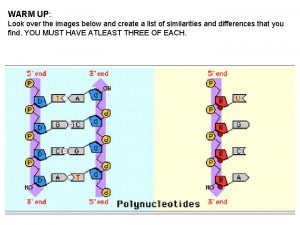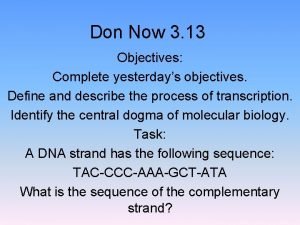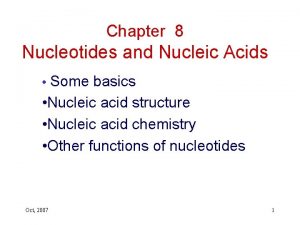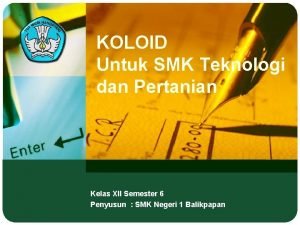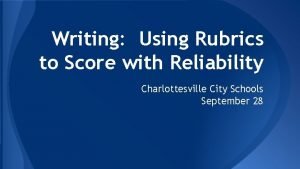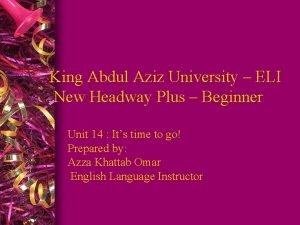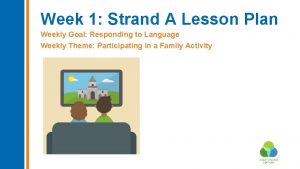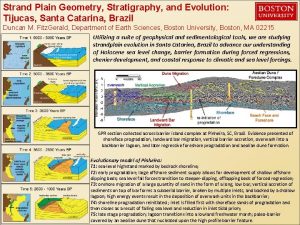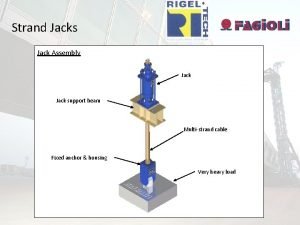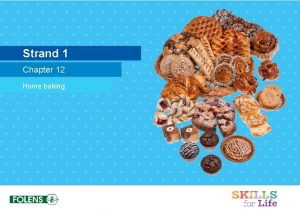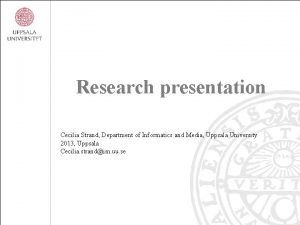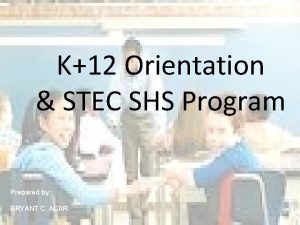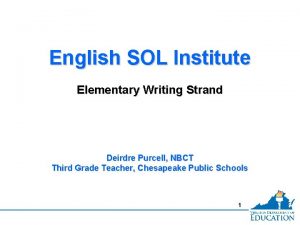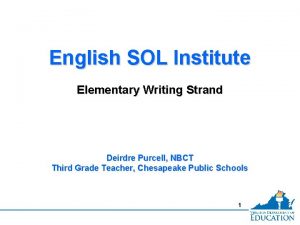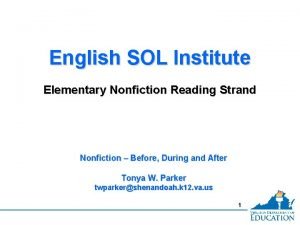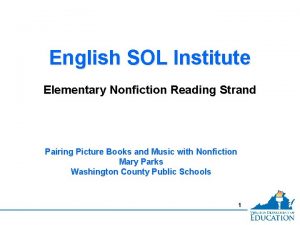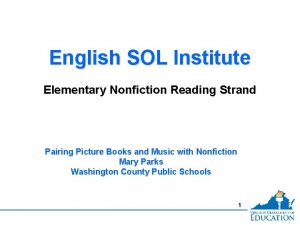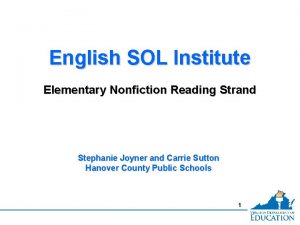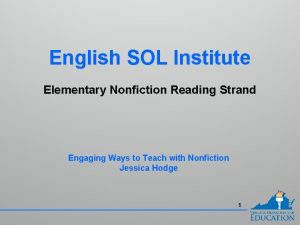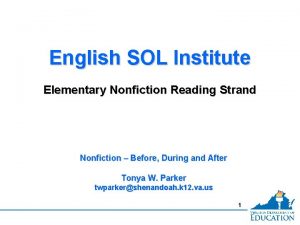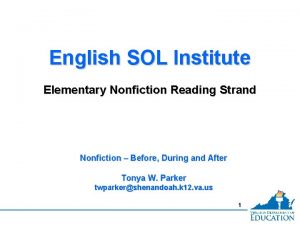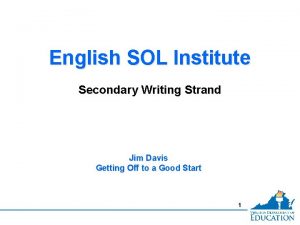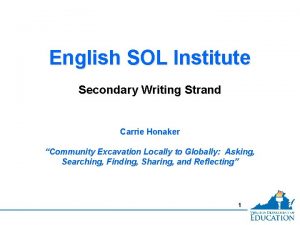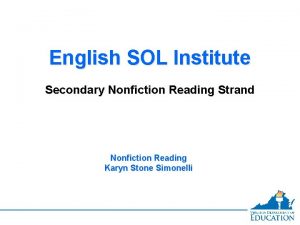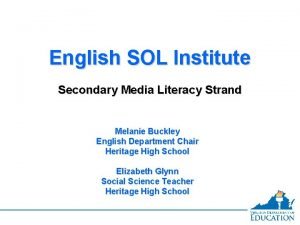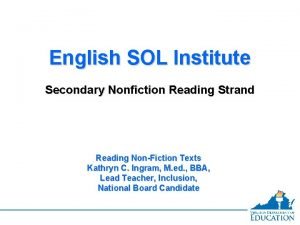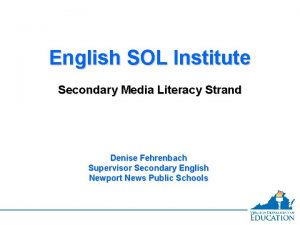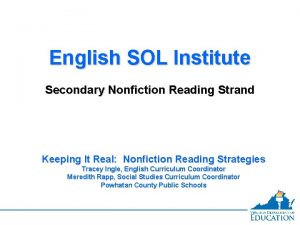English SOL Institute Elementary Writing Strand Genre Study

























- Slides: 25

English SOL Institute Elementary Writing Strand Genre Study: Learning to Read like Writers Kelly Worland Piantedosi kworland@umd. edu 1

Elementary Writing Key Points in Writing • Writing to convey a concise message begins in Kindergarten and moves through grade 3 when students will write a short report • Student use of graphic organizers begins at grade 1 • Beginning in grade 4, students write multiparagraph essays 2

Elementary Writing Key Points in Writing • Persuasive writing begins in 5 th grade • Students in grades 3 -5 should have practice writing on demand, for shorter time frames, and over extended periods of time 3

Today’s objectives. . . • Identify goals for writing instruction and development • Identify common pitfalls for struggling writers • Identify strategies and solutions using genre study and student-centered practices 4

How are we doing? Writing Pass Rate 2010 -2011 All Students* Writing Pass Proficient 2010 -2011 Writing Pass Advanced 2010 -2011 Writing Percent Failed 2010 -2011 84% 60% 24% 16% Where would we like to improve? What needs to change? *average pass rates for Region 4 5

Let’s take a look at some sample essays in your handouts. . . What are the differences between a non-proficient and proficient/advanced writer according to SOL scores? 6

Score of 4 7

Score: 2 8

What are the primary challenges for lower performing students? • Lack of central idea • Lack of specific details and elaboration • Lack of focus 9

What are teachers’ typical solution to these types of problems? • Graphic organizers • Mini-lessons focused on telling students the components of a well-written essay and teacher-modeled writing. • Tell students to add more details • Tell students to cut out sentences that don’t match their central idea 10

Why don’t these approaches work for struggling writers? Novice writers often engage in a knowledge-telling process when they write. Experienced writers use a knowledgetransforming strategy to shape their knowledge for a specific purpose and audience. Figure 1. Bereiter and Scardamalia’s knowledge-telling model (1987). 11

What does knowledge-telling look like in practice? Figure 2. An example of a hierarchical attribute list from Donovan, 2001. 12

Traditional Approach to Writing Instruction: Let’s examine a sample lesson Teach them to read. Teach them to print, spell, and write sentences. Teach them to organize their sentences into longer pieces of writing through teacher-directed modeling. 13

Sample Lesson Systems - Those Mighty, Mighty Ants! By Mary Perrin Ants are amazing insects. They live in colonies. Each colony is a system of ants that work together and depend on one another in order to live. Each colony has worker ants, soldier ants, and one or two queen ants. Their tiny bodies are made to allow them to do different jobs. Each job is important. The colony would not do very well if a job did not get done. Every ant does its part. The worker ants must move the quickest. The worker ants are responsible for many jobs. Worker ants do not live very long. They collect food for the colony, they look after the queen's eggs, and they work hard to protect the nest. The nest is sometimes called an ant hill. An ant hill is a pile of dirt or sand that sits on top of the ground. Ants can also make their nest underground, beneath rocks, and inside old trees, too. Like other insects, ants have six legs. Ants use their strong legs to help them move quickly around the nest. Ants also have three main body parts. They are called the head, thorax, and abdomen. These three body parts allow ants to carry large amounts of weight. Ants can lift twenty times their body weight. For example, if your body weighs fifty pounds, you would be able to lift one thousand pounds all by yourself. That requires a lot of strength. Ants also have two stomachs. They have an extra stomach to store food for the other members of the colony. The next time you see an ant on the sidewalk or climbing around on a leaf, remember that the little ant is doing its very important job. When all the ants do their special jobs, they create something wonderful: an ant hill complete with a nursery for larvae (baby ants), a dump where they put their waste, and even a kitchen where they store all their food. Ants may be tiny, but they are mighty! 14

How do we break the cycle? Kids don’t know what to write We tell them to revise by adding specific details and cutting things that don’t match their main idea. We provide instruction using traditional lesson approaches. They engage in knowledge-telling. 15

Genre Study or teaching our kids to Read Like Writers Start by teaching kids to develop: • A clear and authentic purpose for writing • Persuade • Inform • Entertain/Engage • Combination • An awareness of audience 16

How do we teach this? Guiding principle of the genre study approach: Tell me and I'll forget; show me and I may remember; involve me and I'll understand. ~Chinese proverb 17

Genre Study Approach Step by Step 1. Establish author’s purpose. 2. Provide examples and non-examples of one component of each genre of writing at a time. 3. Ask students to identify which example of writing they prefer and why to gain an awareness of audience. 4. Name the strategy the author used to make that example interesting to their reader. 5. Ask the students to try that strategy in their own writing. 6. Teach kids to reread, revise, and rewrite throughout the drafting process. REVISION SHOULD BE ON-GOING! 18

Sample Genre Components STYLE Narrative Persuasive Informational • Hook/Lead • Sensory details • Dialogue • Character traits, personalities, and feelings (show not tell) • Closure/Satisfying ending • Hook/Lead • Claims and evidence • Author’s voice • Counter-arguments • Concluding statement • Hook/Lead • Descriptive sensory details • Author’s voice • Concluding statement • Introductory paragraph and statement of the problem • Supporting paragraphs with claims and evidence (potential rebuttal of opposing point of view) • Concluding paragraph • Introductory paragraph • Facts organized around themes or subtopics • Concluding paragraph STRUC- • Beginning TURE • Building towards the climax of your story • Denouement *Note—a good narrative does not have to be sequential (think flash-backs, flash-forwards, etc. ) 19

Let’s compare. . . 20

The Missing Link Teach them to organize THEN. . . Teach them to print, their sentences into Teach them to toand write spell, Teach them to read Teach them longer pieces of. Teach writing them to Teach them to READ like through teacher-directed print , spell sentences. and write with a sense read WRITERS in a modeling. write sentences. of purpose and particular genre. audience. 21

Questions and discussion 22

References Bereiter, C. , & Scardamalia, M. (1987). The psychology of written composition. Hillsdale, NJ: Lawrence Erlbaum Associates. Donovan, C. A. (2001). Children’s development and control of written story and informational genres: Insights from one elementary school. Research in the Teaching of English, 35, 395 -447. Lattimer, H. (2003). Thinking through genre: Units of study in reading and writing workshops, 4 -12. Portland, ME: Stenhouse. Wood Ray, K. (2006). Study Driven. Portsmouth, NH: Heinemann 23

Contact Information Kelly Worland Piantedosi kworland@umd. edu 24

Disclaimer Reference within this presentation to any specific commercial or non-commercial product, process, or service by trade name, trademark, manufacturer or otherwise does not constitute or imply an endorsement, recommendation, or favoring by the Virginia Department of Education. 25
 Ring of fire
Ring of fire Mrna strand that is complementary to the dna strand aattgc
Mrna strand that is complementary to the dna strand aattgc Template strand, new strand, base pair, and dna polymerase.
Template strand, new strand, base pair, and dna polymerase. Watson strand crick strand
Watson strand crick strand Watson strand crick strand
Watson strand crick strand Pemisahan koloid dengan cara penyaringan
Pemisahan koloid dengan cara penyaringan Sol writing rubric
Sol writing rubric George mason university english language institute
George mason university english language institute King abdulaziz university english language institute
King abdulaziz university english language institute English language teaching institute
English language teaching institute Thesis statement for argumentative essay
Thesis statement for argumentative essay What is a strand in a lesson plan
What is a strand in a lesson plan History curriculum victoria
History curriculum victoria St regis pool suite bali
St regis pool suite bali Audun fauchald strand
Audun fauchald strand Tijucas
Tijucas Multi strand jack
Multi strand jack Disadvantages of baking
Disadvantages of baking All course in senior high school
All course in senior high school Cecilia strand
Cecilia strand Jeg-støttende principper
Jeg-støttende principper Low relaxation pc strand
Low relaxation pc strand Lagging strand
Lagging strand Strand shs
Strand shs Jan arve strand
Jan arve strand Foley manometer
Foley manometer

